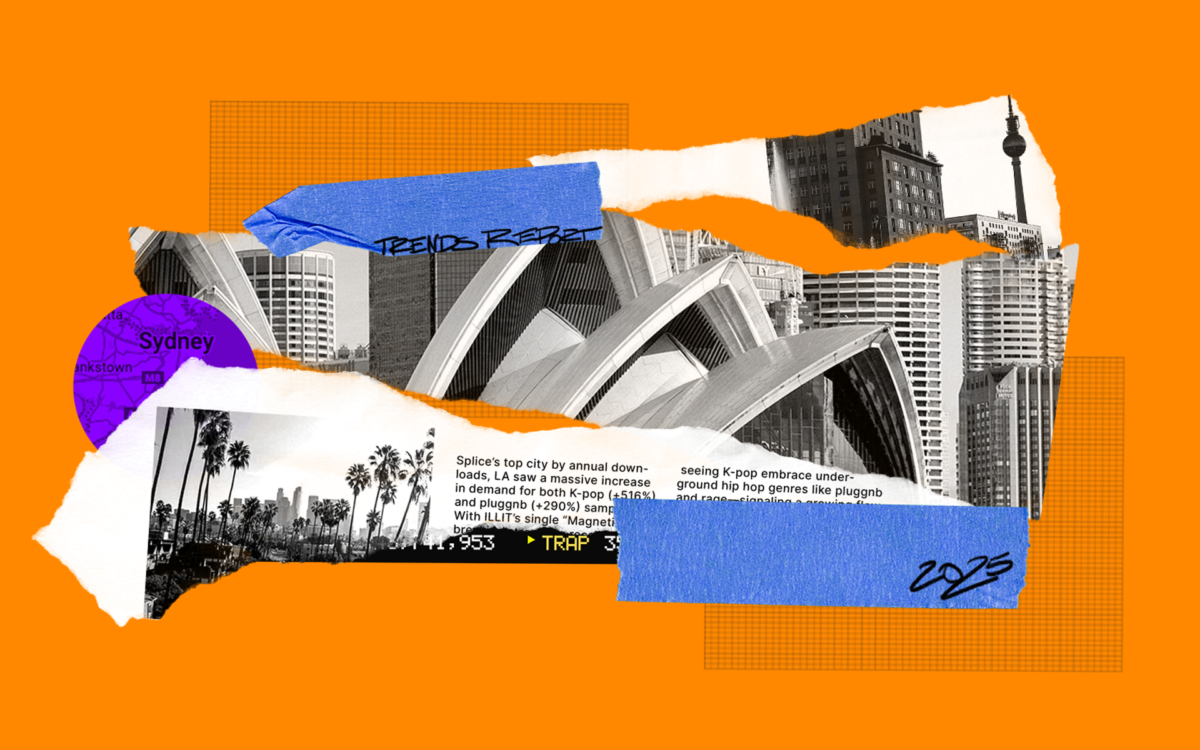In a new report, Sounds of 2025, MIDiA Research explores how the Splice trends of 2024 will help define the musical landscape of the year ahead.
The report delves into emerging genres, sonic shifts, and download patterns on Splice, reflecting broader trends in the global music scene and charting a roadmap for what’s next.
The growing global reach of Splice
While the United States continues to dominate Splice downloads—six of the top ten cities for downloads are in the continental U.S.—Splice’s footprint is increasingly global. Sydney and Melbourne ranked among the top ten cities for downloads, proving Australia’s growing presence and influence on global music culture. Meanwhile, Tokyo and Berlin saw the fastest year-over-year growth among the top ten cities, highlighting Splice’s expanding footprint.
Micro-communities drive innovation
If you’re wondering what’s driving innovation in music, it’s not in catch-all genres like pop and EDM, which have seen declines in downloads. Increasingly, hyper-focused sub-scenes and micro-communities of passionate fans and producers are driving the freshest sounds. Niche styles like Jersey club, pluggnb, and rage—born from hyper-localized scenes—are now thriving as unique local sounds and reshaping the sonic landscape.
K-pop meets pluggnb in Los Angeles
The rising popularity of K-pop and pluggnb, the two fastest-growing genres in Los Angeles, is reshaping Korean pop music and highlighting a deepening cultural exchange between Seoul and LA.
K-pop’s evolving sound, blending hip hop, R&B, and EDM, has created fertile ground for crossover with pluggnb, 2024’s breakout genre. This dynamic fusion was driven by superfans and producers leveraging Splice packs like violet vibes – pluggnb elements to craft tracks that resonate across borders.
Bootleg remixes of K-pop tracks, popularized on platforms like TikTok and YouTube, have captured the music industry’s attention. Artists like LE SSERAFIM and ILLIT are embracing pluggnb in their releases, further cementing the genre’s impact on both sides of the Pacific.
Brazil and the rise of phonk
São Paulo emerged as a hotspot for drift phonk, an offshoot of the phonk genre that originated during the 2010s. Combining phonk’s signature cowbell with Brazilian funk elements, Brazilian phonk became a global craze, gaining traction first in Scandinavia, Eastern Europe, and the UK.
While not originating in Brazil, Brazilian phonk downloads in São Paulo surged fivefold in 2024 and now rival growth rates seen in major European cities. European drift phonk artists such as Kordhell, Freddie Dredd, and Slowboy consistently rank São Paulo among their top Spotify regions. Mc Gw, a Brazillian funk MC from São Paulo and a top 500 Spotify artist at the time of writing, has recently embraced the phonk sound, further exemplifying the genre’s growing influence in Brazil.
Afro house’s global ascendance
In 2024, Afro house surpassed amapiano as South Africa’s leading musical export. Originating from a blend of kwaito, deep, and soulful house in post-apartheid South Africa, Afro house has maintained its authenticity thanks to Johannesburg producers, even as it finds an audience in Europe and America.
The genre saw a 203.9% year-over-year growth in downloads in Johannesburg, making it the city’s third-fastest-growing genre. Producers globally are increasingly searching for and downloading Afro house sounds, reflecting its appeal far beyond its origins. Artists like Kenya’s Sofiya Nzau, Mali’s Salif Keita, and Ghana’s Stevo Atambire are bringing Afro house to new audiences.
Australia: The dance music superfan market
Australia has emerged as a dance music powerhouse. Despite its smaller population of 26 million, Australia overtook the UK as the third-largest market for dance music in 2024. Australians listen to more electronic music artists per capita than any other market, with genres like tech house, big room, and melodic house leading the charge. Searches for Afrobeat and UK garage are also growing, reflecting Australia’s diverse dance music landscape and role as a home to creators shaping global dance music trends.
Berlin’s Jersey club revolution
Berlin, known for its iconic techno scene, saw an unexpected surge in Jersey club, which became its fastest-growing genre in 2024 with a staggering 452.2% increase in downloads. Characterized by its Baltimore club-inspired stuttering kick drum patterns and signature bed squeak, Jersey club offers producers a foundation for experimentation.
The blend of house music and hip hop emerged in the early aughts with artists like Tim Dolla and DJ Tameil. The Jersey club queen, UNIIQU3 fueled its incorporation into the broader EDM world. More recently, choreographed dances helped the genre go viral on TikTok, and artists like Lil Uzi Vert, Cookiee Kawaii, Drake, and Ice Spice released mainstream Jersey club-influenced hits.
As a result, the genre’s signature sounds migrated across the world. Its ties to clubbing are helping it begin a new growth journey in Berlin, where DJs like Berlin Disaster, CEYDAKISS, and UNIIQU3 herself are incorporating it into local sets.
Despite its growth, Jersey club remains underrepresented in Berlin’s search trends, suggesting the genre is still finding its footing. Splice plays a pivotal role in introducing the sound to DJs and producers, fostering its integration into Berlin’s rich electronic music culture.
Invest in scenes, not just genres
The fastest-growing genres and most vibrant music cities on Splice share a common bond: Their success is as much about the surrounding culture as the sounds they produce. Jersey club, for example, mirrors hip hop in its origins, emerging from block parties, spreading through choreographed dances, and celebrating local pride. When a genre becomes a movement—encompassing aesthetics, values, and a sense of belonging—it fosters deeper connections among fans and creators, expanding its reach far beyond its original borders. The takeaway for record labels and A&Rs: Focus on nurturing scenes, not just genres.
Dive even deeper into Splice’s 2024 data:
January 22, 2025





.svg)
.svg)
.svg)
